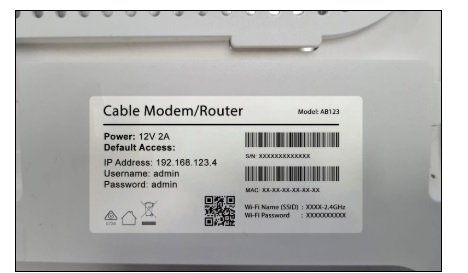The IP address 192.168.123.4 is a private IP commonly used in local networks, such as home or office setups which can be access through http://192.168.123.4.
How to Login to 192.168.123.4?
Step 1: Make Sure You’re Connected to the Same Network
- Note: Please connect the device and computer or smartphone to the similar local network before trying to open log in 192.168.123.4. For example:
- If the device is on your home Wi-Fi network, also connect your computer to the same Wi-Fi.
- If the device is connected using Ethernet, make sure that your computer is also on the same wired network.
- You can test your connection by opening a command prompt (Windows) or a terminal (Mac/Linux) and typing ping 192.168.123.4. If the device is reachable, you’ll get a response. Otherwise, try checking your network again.
Step 2: Open a Web Browser
- Once you’re networked, open a web browser on that device. Google Chrome, Mozilla Firefox, Safari, or Microsoft Edge (other browsers may also work).
Step 3: Paste the IP address into the Address Bar of your browser
- Type http://192.168.123.4 in the browser’s address bar and hit Enter. This will try to reach the device’s web-based management interface.
Step 4: Fill the Login Credentials

- When you go to the IP address, it will most likely prompt you for a username and password. These are often provided by the manufacturer or network administrator. These are some of the common default login credentials:
- Username: admin
- Password: admin or password
- If the default credentials fail, consult the manual for the device or search for a label on the device itself, as that is often where manufacturers print the default login information. If the credentials have been changed and you don’t have them, you might have to reset the device to factory settings.
Step 5: Navigate the Device’s Interface
- Once you are logged in, you’ll have access to the device’s configuration interface
- Depending on the type of device, available options will include:
- Router: Manage network configuration, modify Wi-Fi, control connected devices or upgrade firmware
- Printer: Change print settings, check ink, or troubleshoot problems.
- NAS: File permissions, user setups or backups.
- Fiddle around with the interface and make any adjustments you will need. Take care if you change any settings, as incorrect configurations could break the device.
6 Save Changes and Log Out
- Make sure to save your changes before logging out. Search for a “Save” or “Apply” button in the interface. When you are done, logout of the device to keep your session secure.
Networking is at the base of communication, and IP address is at the base of Networking. Allow devices to identify and communicate with each other on a network. Among the most commonly passed around IP address is 192.168.123.4. While this may just seem like another number, this number can tell you a lot about the internals about how networks operate. This blog will cover 192.168.123.4, as well as information on what it is and why it matters in network and IP addressing. We will also take a look at a real-world case study using this IP address in the field.
Default Username and Password for 192.168.123.4
- Common Default Credentials:
- Username: admin Password: admin
- Username: admin Password: password
- Username: (blank) Password: admin
- Username: admin Password: (blank)
For example:
- TP-Link: Default username and password are often “admin”/“admin” for IPs like 192.168.0.1.
- Netgear: Default username is typically “admin” and password is “password” for IPs like 192.168.1.1 or 192.168.0.1.
- ASUS: Default username and password may be “admin”/“admin” for IPs like 192.168.1.1.
The Structure of an IP Address
Now, in order to understand 192.168.123.4 better we need to look into the format of an IP address. An IP address is a 32-bit integer typically represented in dotted-decimal notation. This notation splits the 32-bit address into four 8-bit groups that are delimited buy dots. A value of each segment can be a number in between 0 and 255.
In the case of 192.168.123.4
- The first part (192) is the network part of the address.
- The network is more narrowly defined as the second segment (168).
- Each segment serves a purpose; the third (123) indicates the subnet.
- The number after the last (4) (the fourth segment) identifies the device in that subnet.
This hierarchical model promotes efficient routing and network management.
Common Issues with 192.168.123.4
192.168.123.4 is a relatively simple IP address, but some common problems can arise when using it on a network:
IP address conflict: Two device on same networks assigned with same IP address may lead to conflict and not communication. So, if another device was wrongly assigned a 192.168.123.4, the printer may stop working.
Incorrect Subnet Mask: The subnet mask also defines the major IP address identifying the network itself and an individual device. Devices may be unable to communicate with each other if the subnet mask is incorrectly configured.
Default Gateway Misconfiguration: The default gateway routes traffic between the local network and the internet. If the default gateway is not correctly set on the devices, they will not be able to reach the internet.
Firewall Restrictions: A firewall can be used to block traffic across devices in the network. Where the printer can’t receive print jobs well, it may be blocked by firewall.
The IP private address 192.168.123.4 is widely used as a means to handle data transfer in private local networks. You can keep a powerful LAN if you know how to configure it and the steps to fix common problems. You’re a home user or an IT pro, when you know private IPs (such as 192.168.123.4), your network never lags.
